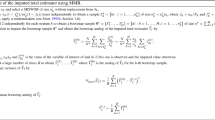Appendix
(1) Proof of Theorem 1
According to the theory of two-phase sampling, the bias of the proposed estimator \({\hat{t}}_{y_{t}^{*}}\) is derived as follows. The estimator in the C group is an unbiased estimator under Assumptions A.2 and A.5, where
$$\begin{aligned}& E_{r}\left({\hat{N}}_{t}^{(C)} | s_{t}^{(C)}\right)=\sum ^{}_{s_{t}^{(C)}}\left(\frac{E_{r}(R_{i,t} | s_{t}^{(C)})}{\pi _{i}\phi _{i,t}^{(C)}}\right) =\sum ^{}_{s_{t}^{(C)}}\frac{1}{\pi _{i}}={\hat{N}}_{t}^{(C,1)},\\& E_{r}\left(\frac{1}{{\hat{N}}_{t}^{(C)}}|s_{t}^{(C)}\right) \approx \frac{1}{E_{r}\left({\hat{N}}_{t}^{(C)}|s_{t}^{(C)}\right)}=\frac{1}{{\hat{N}}_{t}^{(C,1)}},\\ \end{aligned}$$
$$\begin{aligned}&E_{D}E_{r}\left({\hat{t}}_{y_{t}^{(C)}}-t_{y_{t}^{(C)}}|s_{t}^{(C)}\right)\\ &=E_{D}\left[{\hat{N}}_{t}^{(C,1)}E_{r}\left(\frac{1}{{\hat{N}}_{t}^{(C)}}|s_{t}^{(C)}\right)\sum ^{}_{s_{t}^{(C)}} \frac{E_{r}(R_{i,t}|s_{t}^{(C)})}{\pi _{i}\phi _{i,t}^{(C)}}y_{i,t}\right]-t_{y_{t}^{(C)}}\\&\approx E_{D}\left(\sum ^{}_{s_{t}^{(C)}}\frac{y_{i,t}}{\pi _{i}}\right)-t_{y_{t}^{(C)}} =0. \end{aligned}$$
Thus, the bias of the proposed estimator \({\hat{t}}_{y_{t}^{*}}\) is that of the estimator \({\hat{t}}_{y_{t}^{(NC)^{*}}}\) of the NC group,
$$\begin{aligned}E\left({\hat{t}}_{y_{t}^{*}}-t_{y_{t}}\right)&=E_{D}E_{r}\left({\hat{t}}_{y_{t}^{*}}-t_{y_{t}}|s_{t}^{(NC)}\right) \\&=E_{D}E_{r}\left({\hat{t}}_{y_{t}^{(NC)^{*}}}-t_{y_{t}^{(NC)}}|s_{t}^{(NC)}\right)\\&=E_{D}\left[\sum ^{}_{s_{t}^{(NC)}}E_{r}\left(\frac{{\hat{N}}_{t}^{(NC,1)}}{{\hat{N}}_{t}^{(NC)^{*}}}|s_{t}^{(NC)}\right) \frac{E_{r}(R_{i,t}|s_{t}^{(NC)})y_{i,t}}{\pi _{i}\phi _{i,t}^{(NC)^{*}}}-\sum ^{}_{s_{t}^{(NC)}}\frac{y_{i,t}}{\pi _{i}}\right]\\&\approx E_{D}\left[\sum ^{}_{s_{t}^{(NC)}}\frac{y_{i,t}}{\pi _{i}}\left(\frac{{\hat{N}}_{t}^{(NC,1)}}{E_{r}\left({\hat{N}}_{t}^{(NC)^{*}}|s_{t}^{(NC)}\right)} \frac{\phi _{i,t}^{(NC)}}{\phi _{i,t}^{(NC)^{*}}}-1\right)\right]\\&\approx E_{D}\left[\sum ^{}_{s_{t}^{(NC)}}\frac{y_{i,t}}{\pi _{i}}\left(\frac{{\hat{N}}_{t}^{(NC,1)}}{N_{t}^{(NC)^{*}}} \frac{\phi _{i,t}^{(NC)}}{\phi _{i,t}^{(NC)^{*}}}-1\right)\right], \end{aligned}$$
where
$$\begin{aligned} E_{r}\left(\frac{1}{{\hat{N}}_{t}^{(NC)^{*}}}|s_{t}^{(NC)}\right)&\approx \frac{1}{E_{r}({\hat{N}}_{t}^{(NC)^{*}}|s_{t}^{(NC)})}\\&=1/\sum ^{}_{s_{t}^{(NC)}}\frac{\phi _{i,t}^{(NC)}}{\pi _{i}\phi _{i,t}^{(NC)^{*}}}\\&=1/N_{t}^{(NC)^{*}}. \end{aligned}$$
Here, \(E_{D}\) is a first-phase sample expectation based on the sampling design. Given the first-phase sample, the expression in \(E_{D}\) is the bias of the estimator \({\hat{t}}_{y_{t}^{NC^{*}}}\) based on whether a response at wave t exists in the NC group. \(\square\)
(2) Proof of Theorem 2
$$\begin{aligned} MSE({\hat{t}}_{y_{t}^{*}})&=E({\hat{t}}_{y_{t}^{*}}-E({\hat{t}}_{y_{t}^{*}})+E({\hat{t}}_{y_{t}^{*}})-t_{y_{t}})^{2} \\ {}&=E({\hat{t}}_{y_{t}^{*}}-E({\hat{t}}_{y_{t}^{*}}))^{2}+E(E({\hat{t}}_{y_{t}^{*}})-t_{y_{t}})^{2} \\ {}&=E({\hat{t}}_{y_{t}^{*}}-E({\hat{t}}_{y_{t}^{*}}))^{2}+(E({\hat{t}}_{y_{t}^{*}})-t_{y_{t}})^{2} \\ {}&=V({\hat{t}}_{y_{t}^{*}})+(E_{D}E_{r}({\hat{t}}_{y_{t}^{*}}|s)-t_{y_{t}})^{2} \\ {}&=V({\hat{t}}_{y_{t}^{*}})+\{E_{D}Bias_{r}({\hat{t}}_{y_{t}^{*}}|s)\}^{2} \\ {}&=V({\hat{t}}_{y_{t}^{(C)}}+{\hat{t}}_{y_{t}^{(NC)^{*}}})+2Cov({\hat{t}}_{y_{t}^{(C)}},{\hat{t}}_{y_{t}^{(NC)^{*}}}) \\ {}&+\{E_{D}Bias_{r}({\hat{t}}_{y_{t}^{(C)}}+{\hat{t}}_{y_{t}^{(NC)^{*}}}|s)\}^{2} \\ {}&=V({\hat{t}}_{y_{t}^{(C)}})+V({\hat{t}}_{y_{t}^{(NC)^{*}}})+2Cov({\hat{t}}_{y_{t}^{(C)}},{\hat{t}}_{y_{t}^{(NC)^{*}}}) \\ {}&+\{E_{D}Bias_{r}({\hat{t}}_{y_{t}^{(C)}}|i \in s_{t}^{(C)})\}^{2}+\{E_{D}Bias_{r}({\hat{t}}_{y_{t}^{(NC)^{*}}}|i \in s_{t}^{(NC)})\}^{2}. \end{aligned}$$
The variance and covariance based on the response group are given as follows when we regard the respondent sample at wave t as a second-phase sampling.
$$\begin{aligned}&V({\hat{t}}_{y_{t}^{(C)}})=V_{D}E_{r}({\hat{t}}_{y_{t}^{(C)}}|i \in s_{t}^{(C)})+E_{D}V_{r}({\hat{t}}_{y_{t}^{(C)}}|i \in s_{t}^{(C)})\\&V({\hat{t}}_{y_{t}^{(NC)^{*}}})=V_{D}E_{r}({\hat{t}}_{y_{t}^{(NC)^{*}}}|i \in s_{t}^{(NC)})+E_{D}V_{r}({\hat{t}}_{y_{t}^{(NC)^{*}}}|i \in s_{t}^{(NC)})\\&2Cov({\hat{t}}_{y_{t}^{(C)}},{\hat{t}}_{y_{t}^{(NC)^{*}}})=2\{Cov_{D}E_{r}({\hat{t}}_{y_{t}^{(C)}},{\hat{t}}_{y_{t}^{(NC)^{*}}}) +E_{D}Cov_{r}({\hat{t}}_{y_{t}^{(C)}},{\hat{t}}_{y_{t}^{(NC)^{*}}})\}. \end{aligned}$$
If we substitute the variance and covariance expression into the above, the following expression holds.
$$\begin{aligned}&MSE({\hat{t}}_{y_{t}^{*}})\\&=\{V_{D}E_{r}({\hat{t}}_{y_{t}^{(C)}}| i \in s_{t}^{(C)})+E_{D}V_{r}({\hat{t}}_{y_{t}^{(C)}} | i \in s_{t}^{(C)})+\{E_{D}Bias_{r}({\hat{t}}_{y_{t}^{(C)}}|i \in s_{t}^{(C)})\}^{2}\} \\ {}&+\{V_{D}E_{r}({\hat{t}}_{y_{t}^{(NC)^{*}}}|i \in s_{t}^{(NC)})+E_{D}V_{r}({\hat{t}}_{y_{t}^{(NC)^{*}}}|i \in s_{t}^{(NC)}) \\ {}&+\{E_{D}Bias_{r}({\hat{t}}_{y_{t}^{(NC)^{*}}}|i \in s_{t}^{(NC)})\}^{2}\} \\ {}&+2\{Cov_{D}E_{r}({\hat{t}}_{y_{t}^{(C)}},{\hat{t}}_{y_{t}^{(NC)*}})+E_{D}Cov_{r}({\hat{t}}_{y_{t}^{(C)}},{\hat{t}}_{y_{t}^{(NC)*}})\}. \end{aligned}$$
Given that \(\Delta _{ij|s_{t}^{(g)}}=V(I_{i}|s_{t}^{(C)},I_{j}|s_{t}^{(NC)})=\phi _{i,t}^{(C)}\phi _{j,t}^{(NC)}-\phi _{i,t}^{(C)}\phi _{j,t}^{(NC)}=0\), \(Cov_{r}({\hat{t}}_{y_{t}^{(C)}},{\hat{t}}_{y_{t}^{(NC)^{*}}})=0.\)
$$\begin{aligned}&=\{V_{D}E_{r}({\hat{t}}_{y_{t}^{(C)}}| i \in s_{t}^{(C)})+E_{D}mse_{r}({\hat{t}}_{y_{t}^{(C)}}| i \in s_{t}^{(C)})\} \\&+\{V_{D}E_{r}({\hat{t}}_{y_{t}^{(NC)^{*}}} |i \in s_{t}^{(NC)})+E_{D}mse_{r}({\hat{t}}_{y_{t}^{(NC)^{*}}} |i \in s_{t}^{(NC)})\} \\&+2Cov_{D}E_{r}({\hat{t}}_{y_{t}^{(C)}},{\hat{t}}_{y_{t}^{(NC)^{*}}}), \end{aligned}$$
$$\begin{aligned}&=V_{D}E_{r}({\hat{t}}_{y_{t}^{(C)}}|i \in s_{t}^{(C)})+V_{D}E_{r}({\hat{t}}_{y_{t}^{(NC)^{*}}} |i \in s_{t}^{(NC)}) \\ {}&+2Cov_{D}E_{r}({\hat{t}}_{y_{t}^{(C)}}, {\hat{t}}_{y_{t}^{(NC)^{*}}}) \\ {}&+E_{D}mse_{r}({\hat{t}}_{y_{t}^{(C)}}|i \in s_{t}^{(C)})+E_{D}mse_{r}({\hat{t}}_{y_{t}^{(NC)^{*}}}|i \in s_{t}^{(NC)}). \qquad \square \end{aligned}$$
\(\square\)
(3) Proof of Theorem 3
We assume the group response rate \(\phi _{i,t}^{(g)}\) to be known. Because the group mean \(\tilde{y}_{t}^{(g)}\) is a ratio estimator, according to a Taylor linearization, the first order is roughly as follows (Sarndal et al., 1992).
$$\begin{aligned} \tilde{y}_{t}^{(g)}=&\frac{1}{{\hat{N}}_{t}^{(g)}}\sum ^{}_{i \in s^{(g)}}\frac{R_{i,t}y_{i,t}}{\pi _{i}\phi _{i,t}^{(g)}}\\&= \frac{1}{N_{t}^{(g)}}\left({\hat{t}}_{y_{t}}^{(g)}-\frac{{\hat{N}}_{t}^{(g)}}{N_{t}^{(g)}}{t}_{y_{t}}^{(g)}\right) + O(\frac{1}{N_{t}^{(g)2}}),\\&\approx \frac{1}{N_{t}^{(g)}}\left({\hat{t}}_{y_{t}}^{(g)}-{\hat{N}}_{t}^{(g)}{\bar{y}}_{u_{t}}^{(g)}\right),\quad {\hat{t}}_{y_{t}}^{(g)}=\sum ^{}_{s^{(g)}}\frac{R_{i,t}y_{i,t}}{\pi _{i}\phi _{i,t}^{(g)}},\quad {\hat{N}}_{t}^{(g)}=\sum ^{}_{s^{(g)}}\frac{R_{i,t}}{\pi _{i}\phi _{i,t}^{(g)}}, \end{aligned}$$
where \({\bar{y}}_{u_{t}}^{(g)}\) is unknown. We can apply \(\tilde{y}_{t}^{(g,1)}\) rather than \({\bar{y}}_{u_{t}}^{(g)}\) according to Assumptions A.2 and A.5.
$$\begin{aligned} E_{D}E_{r}\left(\tilde{y}_{t}^{(g)}|s_{t}^{(g)}\right)&=E_{D}(\tilde{y}_{t}^{(g,1)})\\&=E_{D}\left(\frac{1}{{\hat{N}}_{t}^{(g,1)}}\sum ^{}_{s_{t}^{(g)}}\frac{y_{i}}{\pi _{i}}\right)\\&={\bar{y}}_{u_{t}}^{(g)}. \end{aligned}$$
The estimator \({\hat{N}}_{t}^{(g)}\) is approximately unbiased for \({N}_{t}^{(g)}\). Therefore,
$$\begin{aligned} \tilde{y}_{t}^{(g)}&\approx \frac{1}{{\hat{N}}_{t}^{(g)}}\sum ^{}_{i \in s^{(g)}}\frac{R_{i,t}u_{i,t}}{\pi _{i}\phi _{i,t}^{(g)}}, \quad u_{i,t}=y_{i,t}-\tilde{y}_{t}^{(g,1)}. \end{aligned}$$
The Taylor linearization of the proposed estimator in the NC group is given as follows.
$$\begin{aligned} {\hat{t}}_{y_{t}^{(NC)^{*}}}&={\hat{N}}_{t}^{(NC,1)}\tilde{y}_{t}^{(NC)^{*}}\\&= \frac{{\hat{N}}_{t}^{(NC,1)}}{N_{t}^{(NC)}}\left({\hat{t}}_{y_{t}}^{(NC)*}-\frac{{\hat{N}}_{t}^{(NC)*}}{N_{t}^{(NC)}}{t}_{y_{t}}^{(NC)}\right) + O\left(\frac{1}{N_{t}^{(NC)2}}\right),\\&\approx \frac{{\hat{N}}_{t}^{(NC,1)}}{N_{t}^{(NC)}}\left({{\hat{t}}}_{{y_t}^{(NC)*\ }}-\frac{{{\hat{N}}}_t^{(NC)*}}{N_t^{(NC)}}t_{{y_t}^{(NC)\ }}\right) \end{aligned}$$
The estimator \({\hat{N}}_{t}^{(NC,1)}\) is approximately unbiased for \({N}_{t}^{(NC)}\) based on A.5. In addition, we can use the unbiased estimator \(\tilde{y}_{t}^{(NC,1)}\) for \({\bar{y}}_{u_{t}}^{(NC)}\). We can therefore express this as follows using \(\frac{{{\hat{N}}}_{t}^{(NC,1)}}{{\hat{N}}_{t}^{(NC)*}}\).
$$\begin{aligned}&\approx \frac{{\hat{N}}_{t}^{(NC,1)}}{{\hat{N}}_{t}^{(NC)^{*}}({{{\hat{N}}}_{t}^{(NC,1)}}/{{\hat{N}}_{t}^{(NC)*}})}\sum ^{}_{s_{t}^{(NC)}}\frac{{{\hat{N}}}_{t}^{(NC,1)}}{{\hat{N}}_{t}^{(NC)*}}\frac{R_{i,t}u_{i,t}}{\pi _{i}\phi _{i,t}^{(NC)^{*}}}\\&= \frac{{\hat{N}}_{t}^{(NC,1)}}{{\hat{N}}_{t}^{(NC)^{*}}}\sum ^{}_{s_{t}^{(NC)}}\frac{R_{i,t}u_{i,t}}{\pi _{i}\phi _{i,t}^{(NC)^{*}}}, \quad u_{i,t}=y_{i,t}-\tilde{y}_{t}^{(NC,1)}. \end{aligned}$$
Using the Taylor linearization rather than the group mean, we obtain the following.
$$\begin{aligned} V_{D}E_{r}&\left({\hat{t}}_{y_{t}^{(C)}} | i \in s_{t}^{(C)},\ R_{i,t}=1\right) +V_{D}E_{r}\left({\hat{t}}_{y_{t}^{(NC)^{*}}} | i \in s_{t}^{(NC)},\ R_{i,t}=1\right)\\&+2Cov_{D}E_{r}({\hat{t}}_{y_{t}^{(C)}}, {\hat{t}}_{y_{t}^{(NC)^{*}}}|R_{i,t}=1,R_{j,t}=1)\\&\approx V_{D}E_{r}\left({\hat{N}}_{t}^{(C,1)}\frac{1}{{\hat{N}}_{t}^{(C)}}\sum ^{}_{s_{t}^{(C)}}\frac{R_{i,t}u_{i,t}}{\pi _{i}\phi _{i,t}^{(C)}}| i \in s_{t}^{(C)}\right)\\&\quad + V_{D}E_{r}\left({\hat{N}}_{t}^{(NC,1)}\frac{1}{{\hat{N}}_{t}^{(NC)^{*}}}\sum ^{}_{s_{t}^{(NC)}} \frac{R_{i,t}u_{i,t}}{\pi _{i}\phi _{i,t}^{(NC)^{*}}}| i \in s_{t}^{(NC)}\right)\\&\quad +2Cov_{D}\left(\frac{{\hat{N}}_{t}^{(C,1)}}{E_{r}({\hat{N}}_{t}^{(C)} | s_{t}^{(C)})}\sum ^{}_{i \in s_{t}^{(C)}}\frac{E_{r}(R_{i,t}|s_{t}^{(C)})u_{i,t}}{\pi _{i}\phi _{i,t}^{(C)}},\right. \\&\quad \qquad \left. \frac{{\hat{N}}_{t}^{(NC,1)}}{E_{r}\left({\hat{N}}_{t}^{(NC)^{*}}|s_{t}^{(NC)}\right)}\sum ^{}_{j \in s_{t}^{(NC)}}\frac{E_{r}(R_{j,t}|s_{t}^{(NC)})u_{j,t}}{\pi _{j}\phi _{j,t}^{(NC)^{*}}}\right). \end{aligned}$$
Because \(E_{r}(\ \cdot \ |s_{t}^{(g)})\) is determined based on the response variable, the expected value is as follows.
$$\begin{aligned} \approx&V_{D}\left(\frac{{\hat{N}}_{t}^{(C,1)}}{E_{r}\left({\hat{N}}_{t}^{(C)}|s_{t}^{(C)}\right)} \sum ^{}_{s_{t}^{(C)}}\frac{E_{r}(R_{i,t}|s_{t}^{(C)})u_{i,t}}{\pi _{i}\phi _{i,t}^{(C)}}\right) \\ {}&+V_{D}\left(\frac{{\hat{N}}_{t}^{(NC,1)}}{E_{r}({\hat{N}}_{t}^{(NC)^{*}}|s_{t}^{(NC)})} \sum ^{}_{s_{t}^{(NC)}}\frac{E_{r}(R_{i,t}|s_{t}^{(NC)})u_{i,t}}{\pi _{i}\phi _{i,t}^{(NC)^{*}}}\right) \\ {}&+2\{E_{D}\left(\frac{{\hat{N}}_{t}^{(C,1)}}{{\hat{N}}_{t}^{(C,1)}}\frac{{\hat{N}}_{t}^{(NC,1)}}{N_{t}^{(NC)^{*}}}\sum ^{}_{i \in s_{t}^{(C)}}\sum ^{}_{j \in s _{t}^{(NC)}}\frac{u_{i,t}}{\pi _{i}}\frac{\phi _{j,t}^{(NC)}u_{j,t}}{\pi {j}\phi _{j,t}^{(NC)^{*}}}\right) \\ {}&\qquad -E_{D}\left(\frac{{\hat{N}}_{t}^{(C,1)}}{{\hat{N}}_{t}^{(C,1)}}\sum ^{}_{i \in s_{t}^{(C)}}\frac{u_{i,t}}{\pi _{i}}\right)E_{D}\left(\frac{{\hat{N}}_{t}^{(NC,1)}}{N_{t}^{(NC)^{*}}}\sum ^{}_{j \in s_{t}^{(NC)}}\frac{\phi _{j,t}^{(NC)}u_{j,t}}{\pi _{j}\phi _{j,t}^{(NC)^{*}}}\right)\}, \end{aligned}$$
where under Assumptions A.2 and A.5, \(E_{r}(R_{i,t}|s_{t}^{(C)})=\phi _{i,t}^{(C)}, \ E_{r}(R_{i,t}|s_{t}^{(NC)})=\phi _{i,t}^{(NC)},\)
\(E_{D}(\frac{{\hat{N}}_{t}^{(C,1)}}{{\hat{N}}_{t}^{(C)}} \sum ^{}_{i \in s_{t}^{(C)}}\frac{u_{i,t}}{\pi _{i}})=0,\quad E_{r}({\hat{N}}_{t}^{(C)}|s_{t}^{(C)})={\hat{N}}_{t}^{(C,1)}\). Thus, we obtain the following expression.
$$\begin{aligned} \approx&V_{D}\left(\sum ^{}_{s_{t}^{(C)}}\frac{u_{i,t}}{\pi _{i}}\right) +V_{D}(\frac{{\hat{N}}_{t}^{(NC,1)}}{N_{t}^{(NC)^{*}}}\sum ^{}_{s_{t}^{(NC)}}\frac{\phi _{i,t}^{(NC)}u_{i,t}}{\pi _{i}\phi _{i,t}^{(NC)^{*}}})\\&+2E_{D}\left(\frac{{\hat{N}}_{t}^{(NC,1)}}{N_{t}^{(NC)^{*}}}\sum ^{}_{i \in s_{t}^{(C)}}\sum ^{}_{j \in s _{t}^{(NC)}}\frac{u_{i,t}}{\pi _{i}}\frac{\phi _{j,t}^{(NC)}u_{j,t}}{\pi _{j}\phi _{j,t}^{(NC)^{*}}}\right). \end{aligned}$$
Noting that \(V_{D}(I_{i}I_{j})=\Delta _{ij}(=\pi _{ij}-\pi _{i}\pi _{j}),\quad E_{D}(I_{i}I_{j})=\pi _{ij}\), we obtain the following.
$$\begin{aligned} \approx&\sum _{U_t^{(C)}}\sum _{U_t^{(C)}}\Delta _{ij}\frac{u_{i,t}}{\pi _{i}}\frac{u_{j,t}}{\pi _{j}} +(\frac{{\hat{N}}_{t}^{(NC,1)}}{N_{t}^{(NC)^{*}}})^{2}\sum _{U_t^{(NC)}}\sum _{U_t^{(NC)}} \Delta _{ij}\frac{\phi _{i,t}^{(NC)}u_{i,t}}{\pi _{i}\phi _{i,t}^{(NC)^{*}}} \frac{\phi _{j,t}^{(NC)}u_{j,t}}{\pi _{j}\phi _{j,t}^{(NC)^{*}}} \\&+2E_{D}(\frac{{\hat{N}}_{t}^{(NC,1)}}{N_{t}^{(NC)^{*}}})\sum ^{}_{i \in U_{t}^{(C)}}\sum ^{}_{j \in U_{t}^{(NC)}}\pi _{ij}(\frac{u_{i,t}}{\pi _{i}}\frac{\phi _{j,t}^{(NC)}u_{j,t}}{\pi _{j}\phi _{j,t}^{(NC)^{*}}}). \end{aligned}$$
\(\square\)
(4) Proof of Theorem 4
We use the approximate Taylor linearization of Theorem (3) to induce the MSE in the group.
\(\textcircled {1}\) The \(E_{D}mse_{r}({\hat{t}}_{y_{t}^{(C)}}|s _{t}^{(C)})\) of the C group is given as follows.
$$\begin{aligned} E_{D}&mse_{r}({\hat{t}}_{y _{t}^{(C)}}|s_{t}^{(C)})\\&=E_{D}E_{r}\left({\hat{t}}_{y_{t}^{(C)}}-E_{r}({\hat{t}}_{y_{t}^{(C)}}) +E_{r}({\hat{t}}_{y_{t}^{(C)}})-t_{y_{t}}|s_{t}^{(C)}\right)^{2}\\&=E_{D}E_{r}\left(\sum ^{}_{s_{t}^{(C)}}\frac{{\hat{N}}_{t}^{(C,1)}}{{\hat{N}}_{t}}^{(C)}\frac{R_{i,t}}{\pi _{i}\phi _{i,t}^{(C)}}u_{i,t} -E_{r}(\sum ^{}_{s_{t}^{(C)}}\frac{{\hat{N}}_{t}^{(C,1)}}{\hat{N_{t}}^{(C)}}\frac{R_{i,t}}{\pi _{i}\phi _{i,t}^{(C)}}u_{i,t})|s_{t}^{(C)}\right)^{2}\\&+E_{D}E_{r}\left[E_{r}(\sum ^{}_{s_{t}^{(C)}}\frac{{\hat{N}}_{t}^{(C,1)}}{{\hat{N}}_{t}^{(C)}}\frac{R_{i,t}}{\pi _{i}\phi _{i,t}^{(C)}}u_{i,t}) -\sum ^{}_{s_{t}^{(C)}}\frac{u_{i,t}}{\pi _{i}}|s_{t}^{(C)}\right]^{2}\\&=E_{D}V_{r}(\sum ^{}_{s_{t}^{(C)}}\frac{{\hat{N}}_{t}^{(C,1)}}{{\hat{N}}_{t}^{(C)}}\frac{R_{i,t}u_{i,t}}{\pi _{i}\phi _{i,t}^{(C)}}|s_{t}^{(C)})\\&=E_{D}\left(\sum ^{}_{s_{t}^{(C)}}\phi _{i,t}^{(C)}(1-\phi _{i,t}^{(C)})(\frac{u _{i,t}}{\pi _{i}\phi _{i,t}^{(C)}})^{2}\right), \end{aligned}$$
where
$$\begin{aligned}&V_{r}(R_{i,t}|s_{t}^{(C)})=\Delta _{ij|s_{t}^{(C)}}=\phi _{i,t}^{(C)}(1-\phi _{i,t}^{(C)}),\quad E_{r}(R_{i,t}|s_{t}^{(C)})=\phi _{i,t}^{(C)},\\&E_{r}\left(\frac{{\hat{N}}_{t}^{(C,1)}}{{\hat{N}}_{t}^{(C)}}|s_{t}^{(C)}\right) \approx \frac{{\hat{N}}_{t}^{(C,1)}}{E _{r}({\hat{N}}_{t}^{(C)}|s_{t}^{(C)})} \approx 1. \end{aligned}$$
The second term bias is zero, leaving only the variance part of the C group. Hence, we derive the MSE of the NC group as follows.
\(\textcircled {2}\) \(E_{D}mse_{r}({\hat{t}}_{y_{t}^{(NC)^{*}}}|s_{t}^{(NC)})\) of the NC group
$$\begin{aligned} E_{D}&mse_{r}\left({\hat{t}}_{y_{t}^{(NC)^{*}}}|s_{t}^{(NC)}\right)\\&=E_{D}E_{r}({\hat{t}}_{y_{t}^{(NC)^{*}}}-t_{y_{t}}|s_{t}^{(NC)})^{2}\\&=E_{D}E_{r}({\hat{t}}_{y_{t}^{(NC)^{*}}}-E_{r}({\hat{t}}_{y_{t}^{(NC)^{*}}}) +E_{r}({\hat{t}}_{y_{t}^{(NC)^{*}}})-t_{y_{t}} |s_{t}^{(NC)})^{2}\\&=E_{D}E_{r}\left(\sum ^{}_{s_{t}^{(NC)}}\frac{{\hat{N}}_{t}^{(NC,1)}}{\hat{N_{t}}^{(NC)^{*}}}\frac{R_{i,t}}{\pi _{i}\phi _{i,t}^{(NC)^{*}}}u_{i,t} -E_{r}\left(\sum ^{}_{s_{t}^{(NC)}}\frac{{\hat{N}}_{t}^{(NC,1)}}{{\hat{N}}_{t}^{(NC)^{*}}}\frac{R_{i,t}}{\pi _{i}\phi _{i,t}^{(NC)^{*}}}u_{i,t}\right)|s_{t}^{(NC)}\right)^{2}\\&\quad +E_{D}E_{r}\left[E_{r}(\sum ^{}_{s_{t}^{(NC)}}\frac{{\hat{N}}_{t}^{(NC,1)}}{{\hat{N}}_{t}^{(NC)^{*}}}\frac{R_{i,t}}{\pi _{i}\phi _{i,t}^{(NC)^{*}}}u_{i,t}) -\sum ^{}_{s_{t}^{(NC)}}\frac{u_{i,t}}{\pi _{i}}|s_{t}^{(NC)}\right]^{2}\\&=E_{D}V_{r}\left(\sum ^{}_{s_{t}^{(NC)}}\frac{{\hat{N}}_{t}^{(NC,1)}}{{\hat{N}}_{t}^{(NC)^{*}}}\frac{R_{i,t}u_{i,t}}{\pi _{i}\phi _{i,t}^{(NC)^{*}}}|s_{t}^{(NC)}\right)\\&\quad +E_{D}E_{r}\left[\sum ^{}_{s_{t}^{(NC)}}\frac{u_{i,t}}{\pi _{i}}(\frac{{\hat{N}}_{t}^{(NC,1)}}{N_{t}^{(NC)^{*}}}\frac{\phi _{i,t}^{(NC)}}{\phi _{i,t}^{(NC)^{*}}}-1)|s_{t}^{(NC)}\right]^{2}\\&=E_{D}\left(\left(\frac{{\hat{N}}_{t}^{(NC,1)}}{\hat{N_{t}}^{(NC)^{*}}}\right)^{2} \sum ^{}_{s_{t}^{(NC)}}\Delta _{ij|s_{t}^{(NC)}}\frac{u_{i,t}}{\pi _{i}\phi _{i,t}^{(NC)^{*}}}\frac{u_{j,t}}{\pi _{j}\phi _{j,t}^{(NC)^{*}}}\right)\\&\quad +E_{D}[\sum ^{}_{s_{t}^{(NC)}}\frac{u_{i,t}}{\pi _{i}}(\frac{{\hat{N}}_{t}^{(NC,1)}}{N_{t}^{(NC)^{*}}} \frac{\phi _{i,t}^{(NC)}}{\phi _{i,t}^{(NC)^{*}}}-1)]^{2}\\&=E_{D}\left(\sum ^{}_{s_{t}^{(NC)}}\phi _{i,t}^{(NC)}(1-\phi _{i,t}^{(NC)})\left(\frac{{\hat{N}} _{t}^{(NC,1)}}{{\hat{N}}_{t}^{(NC)*}}\right)^{2}\left(\frac{u_{i,t}}{\pi _{i}\phi _{i,t}^{(NC)^{*}}}\right)^{2}\right)\\&\quad +E_{D}\left[\sum ^{}_{s_{t}^{(NC)}}\frac{u_{i,t}}{\pi _{i}}(\frac{{\hat{N}}_{t}^{(NC,1)}}{N_{t}^{(NC)^{*}}} \frac{\phi _{i,t}^{(NC)}}{\phi _{i,t}^{(NC)^{*}}}-1)\right]^{2}. \end{aligned}$$
Under Assumption A.2,
$$\begin{aligned}&V_{r}(R_{i,t}|s_{t}^{(NC)})=\Delta _{ij|s_{t}^{(NC)}}=\phi _{i,t}^{(NC)}(1-\phi _{i,t}^{(NC)}),\\&E_{r}(R_{i,t}|s_{t}^{(NC)})=\phi _{i,t}^{(NC)}. \end{aligned}$$
\(\square\)
(5) An asymptotic MSE for each estimator
The MSEs for each estimator are given as follows using the asymptotic MSE formula derived from Theorem 4.
\(\textcircled {1}\) The MSE of \({\hat{t}}_{y_{t}^{(NC)^{*}}}\) is given as follows.
$$\begin{aligned} E_{D}&mse_{r}\left({\hat{t}}_{y_{t}^{(NC)^{*}}}|s_{t}^{(NC)}\right)\\&\approx E_{D}(\sum ^{}_{s_{t}^{(NC)}}\phi _{i,t}^{(NC)}(1-\phi _{i,t}^{(NC)})\left(\frac{{\hat{N}}_{t}^{(NC,1)}}{N_{t}^{(NC)^{*}}}\right)^{2} \left(\frac{u_{i,t}}{\pi _{i}\phi _{i,t}^{(NC)^{*}}})^{2}\right)\\&+E_{D}\left[\sum ^{}_{s_{t}^{(NC)}}\frac{u_{i,t}}{\pi _{i}}\left(\frac{{\hat{N}}_{t}^{(NC,1)}}{N_{t}^{(NC)^{*}}} \frac{\phi _{i,t}^{(NC)}}{\phi _{i,t}^{(NC)^{*}}}-1\right)\right]^{2},\quad u_{i,t}=y_{i,t}-\tilde{y}_{t}^{(NC,1)}, \end{aligned}$$
where
$$\begin{aligned} N_{t}^{(NC)^{*}}&=E_{r}({\hat{N}}_{t}^{(NC)^{*}}|s_{t}^{(NC)})\\&=\sum ^{}_{s_{t}^{(NC)}}\frac{\phi _{i,t}^{(NC)}}{\pi _{i}\phi _{i,t}^{(NC)^{*}}}, \quad {\hat{N}}_{t}^{(NC)^{*}}=\sum ^{}_{s_{t}^{(NC)}}\frac{R_{i,t}}{\pi _{i}\phi _{i,t}^{(NC)^{*}}}. \end{aligned}$$
\(\textcircled {2}\) The MSE of \({\hat{t}}_{y_{t}^{(NC)}}\) may be expressed as
$$\begin{aligned} E_{D}&mse_{r}({\hat{t}}_{y_{t}^{(NC)}}|s_{t}^{(NC)})\\&\approx E_{D}(\sum ^{}_{s_{t}^{(NC)}}\phi _{i,t}^{(NC)}(1-\phi _{i,t}^{(NC)})(\frac{{\hat{N}}_{t}^{(NC,1)}}{{\hat{N}}_{t}^{(NC,1)}})^{2} (\frac{u_{i,t}}{\pi _{i}\phi _{i,t}^{(NC)}})^{2})\\&=E_{D}(\sum ^{}_{s_{t}^{(NC)}}\phi _{i,t}^{(NC)}(1-\phi _{i,t}^{(NC)})(\frac{u_{i,t}}{\pi _{i}\phi _{i,t}^{(NC)}})^{2}),\quad u_{i,t}=y_{i,t}-\tilde{y}_{t}^{(NC,1)}, \end{aligned}$$
where
$$\begin{aligned} E_{r}({\hat{N}}_{t}^{(NC)}|s_{t}^{(NC)})&=E_{r}(\sum ^{}_{s_{t}^{(NC)}}\frac{R_{i,t}}{\pi _{i}\phi _{i,t}^{(NC)}}|s_{t}^{(NC)})\\&=\sum ^{}_{s_{t}^{(NC)}}\frac{1}{\pi _{i}}={\hat{N}}_{t}^{(NC,1)}. \end{aligned}$$
\(\textcircled {3}\) The MSE of \({\hat{t}}_{y_{t}^{(NC_{C})}}\) is given as
$$\begin{aligned} E_{D}&mse_{r}({\hat{t}}_{y_{t}^{(NC_{C})}}|s_{t}^{(NC)})\\&\approx E_{D}(\sum ^{}_{s_{t}^{(NC)}}\phi _{i,t}^{(NC)}(1-\phi _{i,t}^{(NC)}) (\frac{{\hat{N}}_{t}^{(NC,1)}}{N_{t}^{(NC_{C})}})^{2}(\frac{u_{i,t}}{\pi _{i}\phi _{i,t}^{(C)}})^{2})\\&+E_{D}[\sum ^{}_{s_{t}^{(NC)}}\frac{u_{i,t}}{\pi _{i}}(\frac{{\hat{N}}_{t}^{(NC,1)}}{N_{t}^{(NC_{C})}} \frac{\phi _{i,t}^{(NC)}}{\phi _{i,t}^{(C)}}-1)]^{2},\quad u_{i,t}=y_{i,t}-\tilde{y}_{t}^{(NC,1)}, \end{aligned}$$
where
$$\begin{aligned} N_{t}^{(NC_{C})}&=E_{r}({\hat{N}}_{t}^{(NC_{C})}|s_{t}^{(NC)})\\&=\sum ^{}_{s_{t}^{(NC)}}\frac{\phi _{i,t}^{(NC)}}{\pi _{i}\phi _{i,t}^{(C)}}, \quad {\hat{N}}_{t}^{(NC_{C})}=\sum ^{}_{s_{t}^{(NC)}}\frac{R_{i,t}}{\pi _{i}\phi _{i,t}^{(C)}}. \end{aligned}$$





